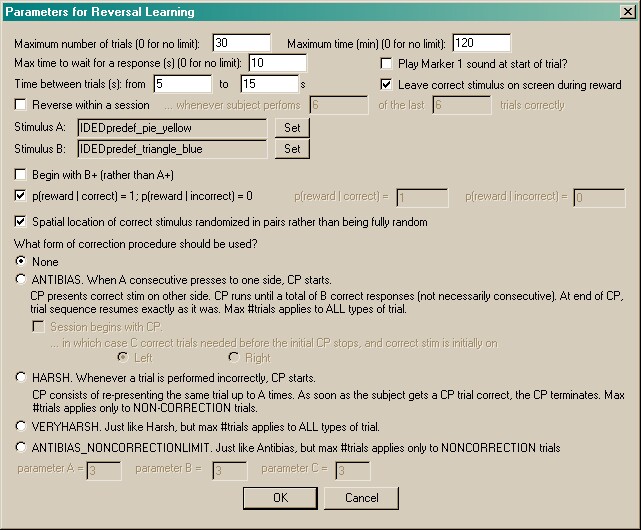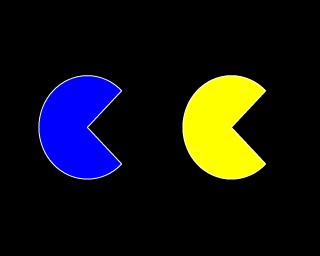About the task
Provides facilities for simple or serial reversal learning, with either two stimuli (A+B- → A-B+) or three (A+B-C- → A-B+C-).
There is an option to use three objects. In this task, a subject is trained with A+B-C- and then reversed to A-B+C-; perseveration can then be measured directly as the degree to which subjects respond to A more than to C. For examples of this task in the recent neurobiological literature, see Arnsten et al. (1997; Neurobiology of Aging 18: 21-28) or Jentsch et al. (2002; Neuropsychopharmacology 26: 183-190). I'm sure this form of the task has a much longer history, but I don't have my copy of Mackintosh (1974; "The Psychology of Animal Learning") to hand!
Configuring the task

| • | Maximum number of trials. When the subject has performed this number of trials, the task ends. (You may specify 0 for no limit, though you must specify a limit on the number of trials, the time, or both.) |
| • | Maximum time. When this time elapses, the task is terminated as soon as the current trial has finished. (You may specify 0 for no limit, though you must specify a limit on the number of trials, the time, or both.) |
| • | Maximum time to wait for a response. If the subject fails to make a response within this time, the subject fails the trial. (You may specify 0 for no limit.) |
| • | Play Marker 1 sound at start of trial? Fairly obvious. |
| • | Time between trials. Specify a minimum and a maximum intertrial time (they may be the same). The actual time is chosen with a rectangular probability distribution within these values. |
| • | Leave correct stimulus on screen during reward. If unticked, all stimuli vanish when one is chosen. If ticked, then if the incorrect stimulus is chosen both vanish; if the correct stimulus is chosen, the incorrect stimulus vanishes and the correct stays for a while (while reward is being delivered). |
| • | Reverse within a session... when subject performs X of the last Y trials correctly. Fairly obvious, I hope. Set the value of X and Y in the boxes. |
| • | Use three stimuli rather than two? Choose whether you want a two-stimulus task or a three-stimulus task. |
| • | Stimuli. Choose the stimuli required by the task (A, B, +/- C). In a three-stimulus task, stimulus C is never correct. |
| • | Begin with B+ (rather than A+)? If you want stimulus B to be correct initially, tick this box. Otherwise, A will be correct. |
| • | Probability of reward given a correct/incorrect response. A conventional reversal procedure has p(reward | correct) = 1 and p(reward | incorrect) = 0. However, if you would like a fully probabilistic reversal task, untick this box. You may then specify p(reward | correct) and p(reward | incorrect) directly. For example, if you specify 0.8 and 0.2, then correct responses would be rewarded 80% of the time, while incorrect responses would be rewarded 20% of the time. |
| • | If you reward some "incorrect" responses, and you have chosen the option "Leave correct stimulus on during reward", the program will leave the chosen stimulus on (i.e. one that is notionally "incorrect", but is being rewarded on this trial). This seems the only consistent thing to do. Essentially, a probabilistic task blurs the definition of "correct" and "incorrect", so the option is best described as "Leave chosen stimulus on if it's rewarded"! |
| • | Spatial location of correct stimulus randomized in pairs... |
| • | If this box is not ticked, the location of the correct stimulus is chosen at random for each trial (and, in the three-stimulus task, the location of the "incorrect but correct in the past" and the "never correct" stimuli are similarly chosen at random). |
| • | If this box is ticked, then the locations are randomized in pairs (for the two-stimulus task), meaning that in every pair of trials, the correct stimulus is on the left on one trial and on the right in the other, but the order of those two trials within the pair is random. For the three-stimulus task, there are six possible spatial combinations (ABC, ACB, BAC, BCA, CAB, CBA) and in every six trials one of these combinations will be used, with the order within the group of six being random. |
| • | Correction procedure. Choose the type of correction procedure (CP) you wish to use. The meaning of the types of correction procedure is explained carefully in the dialogue box. Note that if you allow within-session reversals and your subject achieves the criteria for reversing, any ongoing correction procedure is cancelled, and all correction procedure counts are reset. |
| • | If the "antibias" correction procedure is employed with a three-stimulus task and the subject perseverates in the middle, then the correct stimulus is randomly assigned to the left or the right location for the correction procedure. If it perseverates on the left, then the correct stimulus is assigned to the right-hand side; if it perseverates on the right, the correct stimulus is assigned to the left-hand side. In all cases, once the correction procedure has determined where the correct stimulus is to be, it chooses the location of the "incorrect but once correct" stimulus and the "never correct" stimulus (C) at random. |
Screenshots of the task
The moment of choice.

In this case, the subject responded correctly and correct stimuli are being left up during reward:
